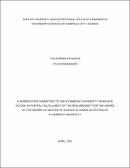| dc.description.abstract | Introduction: The diet one takes is very fundamental for boosting and sustaining one’s health and nutrition’s needs especially when it is a balanced diet. Dietary diversity is vital for exposing the learners to different nutrients. Proper dietary diversity boosts education of learners and sustains their health and nutrition. The main objective of the study was to assess diet adequacy, nutritional status and nutrition and health education of learners in Kampala City, Uganda. Specifically, to assess the nutritional status determinants, establish the existing school menu options and adequacy of diet accessed by learners and to identify nutrition and health education activities emphasised in schools in Kampala City.
Methodology: The study units included non-boarding secondary schools in the two divisions of Kampala Central and Kawempe. The study employed a cross-sectional design and descriptive in nature with qualitative and quantitative methods. The sample size of 240 respondents was selected. In addition, 24 key informants that is to say a head teacher and teacher responsible for nutrition matters were considered for the interviews from the 12 schools, 6 in each division. The study also employed multi-stage simple random sampling with three stages of sampling, criterion-based sampling and purposive sampling. Statistical analysis involved ANOVA techniques for finding mean differences while correlations were used for continuous variables at 0.05 statistical significance. The BMI z scores were got using WHO Anthro plus of 2007.
Results: The mean (SD) age of learners was 15.6 (1.6), BMI Z-score 0.5 (1.1) and DDS 6.1(2.3). Majority of learners 80.5% had normal nutritional status: 11.7% underweight, 5.9% overweight and 1.9% obese. There was a strong significant correlation between age and BMI of learners (p < 0.001; r = 0.721) which implies that BMI increases with age of learners. There was a relationship between mean BMI and parental level of education (p = 0.001) and grade of learners (p = 0.031). Majority of the respondents 66.8% consumed 6 or more food groups. The most provided school foods included; mingled maize meal (posho), beans, rice, greens and maize porridge with meat, fish, groundnuts, maize on the cob and Green cooked banana (matooke) accessed within a week. All schools offered nutrition and health education activities the commonly offered being emergency preparedness, physical activity and fitness and counselling.
Conclusion: It was established that majority of the learners had a normal nutritional status and it was positively associated with parental income source, grade and age of learners. Majority of the learners consumed 6 or more food groups and were getting lunch at school.
This study findings have implications on public health nutrition and quality education. Where possible, there is need for improving nutritional sensitivity of meals provided by providing animal source foods that are rich sources of essential nutrients as part of the menu. Being an urban setting and given that one of every 10 learners assessed were in the overweight and obesity risk category, school-focused policy measures and guidelines promoting healthy school meals and food environments might be needed to check this problem from increasing among learners. | en_US |

